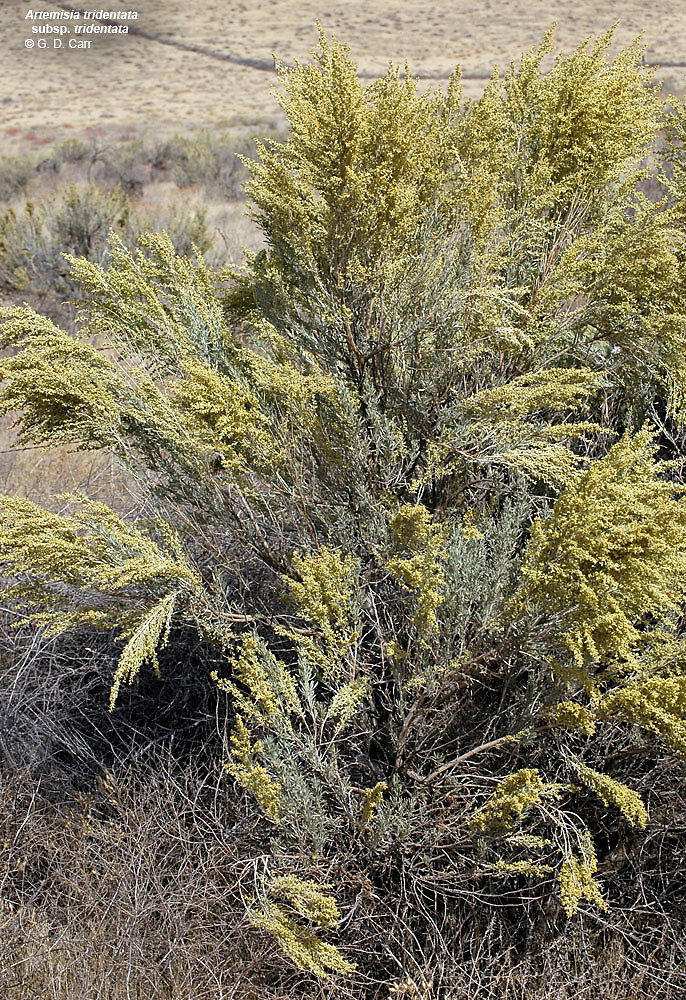INTRODUCTION
ARTEMISIA PLANT
Common name: wormwood, sagebrush, big sagebrush
Scientific name: Artemisia tridentata
- is a large, diverse genus of plants with between 200 and 400 species belonging to the daisy family Asteraceae and the kingdom Plantae. It comprises hardy herbaceous silvery-gray bush with yellow flowers and grows in arid sections of the Western United States.

- The root is perennial (lasting a period of time) from it arise branched, firm, leafy stems, sometimes almost woody at the base. The leaf stalks are slightly winged at the margin. The leaf segments being narrow and blunt (dull). The flowering stem is 2 to 2 1/2 feet high and white, being closely covered with fine silky hairs. The flowers are pendulous and has a green-yellowish color and bloom from months of July to October. The fruits are tiny and is crowded into a tiny spent flower head. It is suitable for light (sandy) and medium (loamy) soils, prefers well-drained soil and can grow in nutritionally poor soil. It cannot grow in shade but it will grow in dry and moist soil that can tolerate drought.
ACTIVE CONSTITUENTS
Chemically, the active medicinal constituents of this plant include camphor, terpenoids and tannins.
The camphor-like odor was used as an air freshener or as a strewing herb. Terpenoids from the leaves is a major component of its essential oils. Essential oils are natural and complex compounds by aromatic plants, like Artemisia. It is composed of oxygenated monoterpenes, artemisia ketone and camphor. It can be attributed to its properties as deodorant, digestive and a tonic substance.
TRADITIONAL USE
Artemisia plant was used as a herbal medicine by Native Americans especially for preventing infection in wounds, stopping internal bleeding, and treating headaches and colds. The Navajo people from the Southwestern used the vapors of sagebrush as treatment for headache. The Okanagan (First Native Americans) and The Colville from the Northwestern used sagebrush to smoke hides. A decoction of the leaves for the treatment digestive disorders, colds and for fevers. And also, steeped leaves for sore eyes. It is used now in modern herbalism. Humans have used the plant primarily as firewood, the volatile oils is responsible for its pungent aroma. It is flammable that can cause burn.
PHARMACOLOGICAL ACTIVITY
Artemisia tridentata, more commonly referred to as sagebrush, has been documented for centuries regarding its potential medicinal uses. This plant is believed to stop internal bleeding and has a history of being used following traumatic injury or childbirth. It is also believed to possess natural disinfectant properties and may be used to treat sores or other open wounds. Many health care professionals consider Artemisia tridentata to be toxic to humans, so a doctor should be consulted before beginning treatment with this supplement. The sagebrush plant was often used to treat digestive disorders and was believed to help expel worms and other parasites from the digestive tract. It was commonly used to make skin ointments or antiseptic washes in order to prevent infection. The disinfectant properties of this plant were thought to be so strong that it was also used as a floor wash or burned as an incense to kill germs in the house after there had been an illness in order to prevent others from getting sick.
TOXICITY
Michael Moore states that sagebrush alters liver drug metabolism. The essential oils are toxic to the liver and digestive system of humans if taken internally, so care must be taken during any form of internal use.In other words, taking desert sage concurrently with an allopathic drug may give unexpected side effects. He also points out that Artemisia tridentata is inappropriate to take during pregnancy, as it is a uterine vasodilator. Additionally, it should not be used while nursing, as it may be present in the milk. The herb may be relatively harmless, but he states that “considering the highly reactive state of pregnancy and the fact that fetal growth is a template that can manifest pharmacokinetics very differently than for an adult”, this herb is mentioned in his list of herbs to avoid during pregnancy and breast-feeding.The sagebrush can be a abortifacient to livestock and women. It is contraindicated in pregnancy and during lactation. As mentioned previously, there is little current research on the effects of Artemisia tridentata on the human body.
REFERENCES
- Artemisia (genus), http://en.wikipedia.org/wiki/Artemisia_(genus)
- M. Grieve, Wormwoods, http://www.botanical.com/botanical/mgmh/w/wormwo37.html
- Nature's Notebook, Artemisia tridentata, https://www.usanpn.org/nn/Artemisia_tridentata
- Plants For A Future, Artemisia tridentata - Nutt., http://www.pfaf.org/user/Plant.aspx?LatinName=Artemisia+tridentata
- Tassy, Artemisia tridentata also known as Big Sagebrush, http://tolweb.org/treehouses/?treehouse_id=4623
- Native Plants, Artemisia tridentata, http://www.wildflower.org/plants/result.php?id_plant=ARTR2
- Horizon Herbs, Sagebrush, Common (Artemisia tridentata), packet of 200 seeds, https://www.horizonherbs.com/product.asp?specific=1601
- Organic Facts, Health Benefits of Wormwood Essential Oil, http://www.organicfacts.net/health-benefits/essential-oils/health-benefits-of-wormwood-essential-oil.html
- Quintessential Oils, Essential Oils Index (S thru Z), http://www.quintoils.com/pages/miscellaneouspages/eostozindex.html
- Wise Geek, What Are the Medical Uses of Artemisia Tridentata?, http://www.wisegeek.net/what-are-the-medical-uses-of-artemisia-tridentata.htm
- Laura Bergeson. (2006) Dr. Christopher's Herbal Legacy, Desert Sage, http://www.herballegacy.com/Bergeson_Contra.html
Compiled by: Daniella Bacaran

No comments:
Post a Comment